• The Riksbank is (reluctantly?) taking things step by step.
• We see little reason to alter our trading recommendations. Instead, we find support for our strategies when we read the Riksbank. Keep BEI tighteners, SGBi3105/SGB1049 and short-dated covered bonds versus government bonds. Moreover, remain positioned for more relative steepening of the SEK swap curve versus the EUR swap curve in the 10Y/5Y segment.
• The Riksbank is off track of CPI inflation by 0.3 percentage points in its brand new forecast for January. This spread may widen to 0.6 by February. This should put pressure on the Riksbank to cut the repo rate again in April.
Trades
Closed, the TED spread used as a hedge against fixing woes as a protection for shortdated covered bonds. FRAMAR13 versus RIBAJUN13. Closed with a loss -6bp.
Closed, TED spread box FRAMAR12/RUBAJUN12 against FRAJUN12/RIBASEP12. Closed with a profit of +4bp.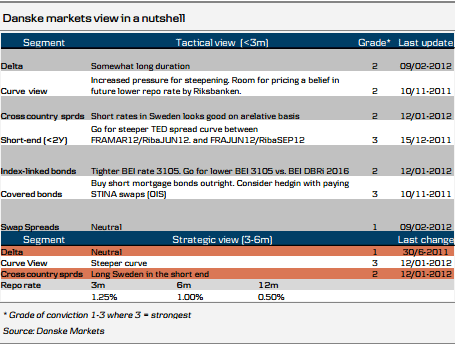
Step by step
A 25bp rate cut and then on hold until mid-2013. Except for Riksbank board members Karolina Ekholm and Lars Svensson one gets the impression that the Riksbank is cutting rates with considerable reluctance. Then again, in order to figure out what to expect going forward, the thing to do is identify possible “weak spots” in the Riksbank forecasts. As a curiosity, it can be noticed that the January CPI/CPIF data that were reported at the same time as the rate announcement came in three tenths of a percentage point below the Riksbank forecast. Indeed, the actual CPIF y/y figure (0.86) is slightly on the low side of
the lowest point in the Riksbank’s revised projection (0.93 for May 2012). However, to be fair, this probably does not make a world of difference.
The Riksbank lowered its 2012 growth projection in calendar adjusted terms from 1.7% to 1.0%. According to us, this is still too optimistic. Therefore, the Q4 GDP data (due to be reported on 29 February) remains important as it sets the starting point for this year. The Riksbank expects annualised growth of -1.67% for Q4, which translates into a q/q figure of around -0.4%. We believe there is a risk of a steeper decline (some -1% q/q) unless inventories rise a lot, which would be a negative thing, because that would no doubt, in our view, be an unintended accumulation of inventories.
Second, the labour market. This time the Riksbank has factored in higher unemployment but not much higher. The total increase from today is 0.4 percentage points to a peak of 7.8% in Q2 this year, followed by a pretty steep decline. In our opinion, the Riksbank’s forecast is in our minds far too optimistic given that: (1) unemployment started to pick up in Q4 11, (2) lay-offs over the four months to the end of January increased by more than 10,000 compared with the level a year ago and the typical lag between lay-offs and unemployment is up to six months (i.e. lay-offs have not so far affected UNR a lot) and (3) a considerable number of people can lose their jobs without any lay-off notices,namely temporary employees whose contracts simply expire. Also, the period over which unemployment is seen moving higher is very short.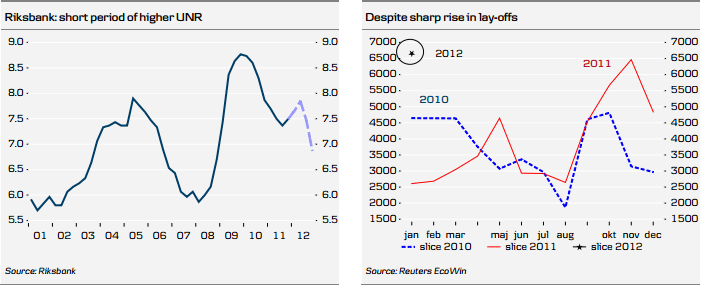 An interesting observation is to compare the growth profile during 2001-04. The current GDP forecast is almost a copy-paste of that episode. The IT crash hurt GDP growth in 2001 but by 2002 growth was back at 2.0-2.5%. Unemployment, however, started to increase in 2001 and continued to do so until mid-2005 – a total increase of around 2 percentage points.
An interesting observation is to compare the growth profile during 2001-04. The current GDP forecast is almost a copy-paste of that episode. The IT crash hurt GDP growth in 2001 but by 2002 growth was back at 2.0-2.5%. Unemployment, however, started to increase in 2001 and continued to do so until mid-2005 – a total increase of around 2 percentage points. This time round we expect the labour market to respond very differently.
This time round we expect the labour market to respond very differently.
If we prove broadly correct, the Riksbank will have to lower growth projections again and revise up unemployment. Svensson and Ekholm will continue to call for aggressive rate cuts, while it may be that the board majority reluctantly cuts rates – step by step – and after each rate cut signals that no more easing is to be expected. As unemployment continued to rise throughout 2004 – despite decent growth – the 2/10 government curve steepened from around 65bp to a peak of some 175bp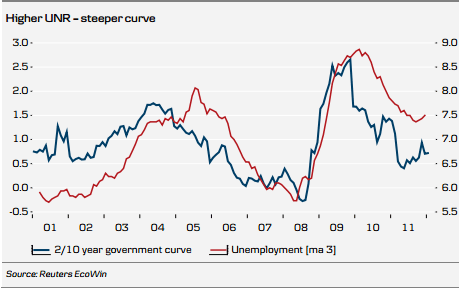 Expect more cuts to come
Expect more cuts to come
We see little reason to alter our trading recommendations. Instead, we find support for our strategies when we read the Riksbank forecasts. We believe the central bank’s forecasts are still too optimistic and expect key data such as unemployment and, primarily, inflation to continue to surprise the Riksbank (see more above). Its inflation forecast was already too high when it was published. The Riksbank expects CPIF to reach its lowest reading in May at 0.93%. However, it was already below that (0.9%) when the January outcome was published (at the same time as the rate decision). According to our forecasts, the February outcome will be 0.6% below the Riksbank’s brand new forecast.
As we expect the the inflation rate to continue to decline, we see even tighter BEI rates going forward, despite the move following the January CPI outcome. Hence, hold on to the SGBi3105 BEI tightener. We also expect more performance in shorter covered bonds against government bonds. Keep these positions as well. We expect more relative steepening of the Swedish swap curve relative to the EUR swap curve. Keep the 10Y/5Yswap curve box.
The TED spread widener FRAMAR13 versus RIBAJUN13 has served as a hedge against more fixing woes in order to protect short-dated covered bond positions. Now we feel more confident that fixings will gradually grind lower and close the hedge for now at least. The FRA/RIBA TED box was also established as a security for fixing spreads. We close this position as well. For a more detailed list of current trading recommendations, see the table at the back of this publication.
January inflation: a sign of what is coming?
Both CPI and CPIF inflation were as low as we had expected in January, with CPI actually even lower because there was – after all – a “reweighting effect” from the mortgage component. Our preliminary take was that there would be no such effect this year but that other price components may very well contain such a negative effect on the inflation rate (both CPI and CPIF) as has been the case for many years now.
It also turned out that clothing sales were higher than we expected – a risk that we had signalled. Also, the impact of the restaurant VAT cut was very small, only 15% (we thought we were low, as we figured only fast food chains had indicated price cuts). Most restaurants apparently put the VAT proceeds in their pockets, raised profitability and let consumers pay the same price as before. It remains to be seen whether there will be any delayed effect of the VAT cut in coming months.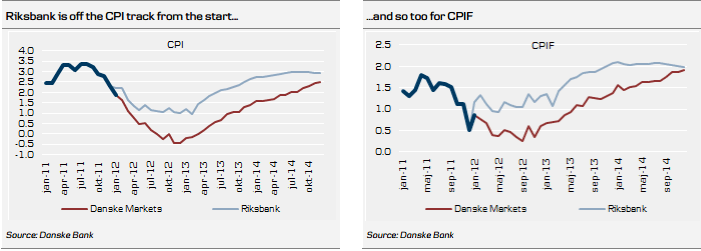
In other words, our inflation forecasts are almost completely unchanged following the January outcome. As before, we continue to see both CPI and CPIF inflation getting close to zero by the end of the year. An overall wage outcome at around 3.5% would imply a CPIF rate at 1.5%. However, our view is that this base level is likely to be pressed further down by sagging consumer sentiment, a stable/strong krona keeping import prices in check, sharply lower electricity prices again as the combined shock of colder weather and the temporary shutdown of a nuclear plant wears off and water reservoirs remain well above normal and, finally, world prices on food commodity prices. To be sure, oil prices may very well rise, pushing petrol prices to new record levels. Taken together, we retain our call that inflation will come very close to zero later this year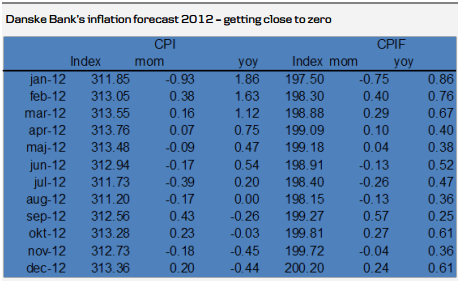
- English (UK)
- English (India)
- English (Canada)
- English (Australia)
- English (South Africa)
- English (Philippines)
- English (Nigeria)
- Deutsch
- Español (España)
- Español (México)
- Français
- Italiano
- Nederlands
- Português (Portugal)
- Polski
- Português (Brasil)
- Русский
- Türkçe
- العربية
- Ελληνικά
- Svenska
- Suomi
- עברית
- 日本語
- 한국어
- 简体中文
- 繁體中文
- Bahasa Indonesia
- Bahasa Melayu
- ไทย
- Tiếng Việt
- हिंदी
Swedish Markets Update: February 17, 2012
Published 02/17/2012, 10:05 AM
Updated 05/14/2017, 06:45 AM
Swedish Markets Update: February 17, 2012
Latest comments
Loading next article…
Install Our App
Risk Disclosure: Trading in financial instruments and/or cryptocurrencies involves high risks including the risk of losing some, or all, of your investment amount, and may not be suitable for all investors. Prices of cryptocurrencies are extremely volatile and may be affected by external factors such as financial, regulatory or political events. Trading on margin increases the financial risks.
Before deciding to trade in financial instrument or cryptocurrencies you should be fully informed of the risks and costs associated with trading the financial markets, carefully consider your investment objectives, level of experience, and risk appetite, and seek professional advice where needed.
Fusion Media would like to remind you that the data contained in this website is not necessarily real-time nor accurate. The data and prices on the website are not necessarily provided by any market or exchange, but may be provided by market makers, and so prices may not be accurate and may differ from the actual price at any given market, meaning prices are indicative and not appropriate for trading purposes. Fusion Media and any provider of the data contained in this website will not accept liability for any loss or damage as a result of your trading, or your reliance on the information contained within this website.
It is prohibited to use, store, reproduce, display, modify, transmit or distribute the data contained in this website without the explicit prior written permission of Fusion Media and/or the data provider. All intellectual property rights are reserved by the providers and/or the exchange providing the data contained in this website.
Fusion Media may be compensated by the advertisers that appear on the website, based on your interaction with the advertisements or advertisers.
Before deciding to trade in financial instrument or cryptocurrencies you should be fully informed of the risks and costs associated with trading the financial markets, carefully consider your investment objectives, level of experience, and risk appetite, and seek professional advice where needed.
Fusion Media would like to remind you that the data contained in this website is not necessarily real-time nor accurate. The data and prices on the website are not necessarily provided by any market or exchange, but may be provided by market makers, and so prices may not be accurate and may differ from the actual price at any given market, meaning prices are indicative and not appropriate for trading purposes. Fusion Media and any provider of the data contained in this website will not accept liability for any loss or damage as a result of your trading, or your reliance on the information contained within this website.
It is prohibited to use, store, reproduce, display, modify, transmit or distribute the data contained in this website without the explicit prior written permission of Fusion Media and/or the data provider. All intellectual property rights are reserved by the providers and/or the exchange providing the data contained in this website.
Fusion Media may be compensated by the advertisers that appear on the website, based on your interaction with the advertisements or advertisers.
© 2007-2025 - Fusion Media Limited. All Rights Reserved.
